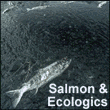forum
library
tutorial
contact

Boost in Other Nesting Sites
Aims to Shrink Terns' Colony
by Joe Rojas-Burke
The Oregonian, January 15, 2005
|
the film forum library tutorial contact |

|
Boost in Other Nesting Sites
by Joe Rojas-Burke
|
A federal plan proposes to disperse
the world's largest concentration of the birds at the mouth of the Columbia
A plan to scatter the world's largest breeding colony of Caspian terns, located near the mouth of the Columbia River, moved a step closer to realization Friday, despite objections from some conservation groups.
More than 18,000 of the diving birds -- two-thirds of the West Coast population -- gather each spring on the Columbia's East Sand Island, after a successful relocation from an upriver island where they preyed on young salmon migrating downriver.
The U.S. Fish and Wildlife Service in July proposed to disperse the terns again to alternate nesting sites. Officials gave two reasons: to further protect threatened and endangered Columbia River salmon, and to make the terns less dependent on a single nesting area that could be wiped out by extreme weather or disease.
The plan released Friday, which will become final in 30 days, would reduce the nesting population at East Sand Island to one-third its current size by letting grass and brush take over nesting grounds. Managers would clear enough ground to allow about 5,000 to 6,000 pairs to continue breeding on the island.
Before any nesting ground gets eliminated at East Sand Island, the plan calls for the expansion of nesting habitat at Summer, Crump and Fern Ridge lakes in Oregon; the Dungeness National Wildlife Refuge in Washington; and three places in California's San Francisco Bay.
Some bird advocates aren't convinced of the need to disperse the terns.
Gerald Winegrad of the American Bird Conservancy said terns pose an insignificant threat to salmon compared with hydropower dams, fishing and habitat loss driven by development. The conservancy and three other groups sued to block an earlier effort to discourage tern nesting in the name of salmon recovery.
As part of a legal settlement, federal agencies agreed to maintain the six acres of nesting grounds on East Sand Island until 2005 and to study how to handle the giant tern colony.
The birds crowded into the Columbia River estuary as development destroyed nesting sites along the West Coast. Nesting boomed on Rice Island, 15 miles inland from the ocean, where gravel from river dredging created ideal nesting grounds, and young salmon and steelhead -- including tens of millions produced by hatcheries -- became easy prey.
The relocation to East Sand Island began in 1999, based on the idea that terns would eat fewer salmon with a variety of ocean fish to catch. The U.S. Army Corps of Engineers planted grasses to thwart nesting on Rice Island, and it bulldozed clearings for the birds on the downstream island. Biologists set out tern decoys and played recordings of tern mating calls to lure the birds.
The efforts paid off. Studies at East Sand Island show that terns are eating mostly herring, anchovy, shiner perch, sculpins and other ocean fish, but relatively few salmon. The terns' consumption of salmon and steelhead has dropped by about two-thirds through 2003. With such results, bird advocates said federal agencies are pushing too hard to disperse the terns.
Dave Allen, the Fish and Wildlife Service's Pacific region director, said relocation would have significant benefits for Columbia Basin salmon and steelhead. For example, he said it could boost growth rates of affected steelhead runs by 1 percent or more.
learn more on topics covered in the film
see the video
read the script
learn the songs
discussion forum
